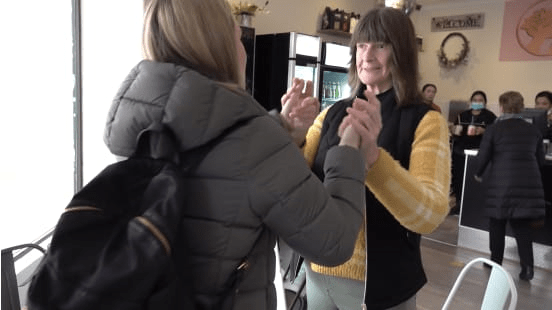It’s a scene played out hundreds of times a day across Australia. Two people enter a cafe for coffee and a bite to eat. But something here is different.
They are touching hands as they walk in and sit down. One of the people is blind. They are also deaf. The other person touches their hands to communicate. This is tactile sign language.
It is used by people who are both deaf and blind – but generally were born deaf and went blind as adults. The “listener” places their hands on those of the “speaker” to feel what is being signed. Some tactile signers can still see or hear a bit, while others are totally deaf and blind.
But there is a real shortage of Auslan interpreters who know how to work with this group.
Australia’s National Accreditation Authority for Translators and Interpreters (NAATI) sets and maintains high national standards for the translating and interpreting sector. It has launched a new certification – Recognised Practising Deafblind Interpreter. Monash University will be running the first training cohort for this certification later this year.
The certification has come out of a Linkage Project between Monash researchers, led by Associate Professor in Linguistics, Louisa Willoughby from the Arts Faculty, Able Australia and NAATI.
“Having a recognised training and certification process gives interpreters a pathway to develop their skills in this area and deafblind people, and agencies who support them, confidence in the skills of interpreters hired to work with them,” Willoughby said.
NAATI CEO Mark Painting said: “The establishment of a credential in Deafblind interpreting is an exciting and important addition to the NAATI Certification System.
“Not only will this credential support the provision of high-quality interpreters for deafblind people across Australia, but it will also recognise the unique skills and experience of the practitioners who work in this space.”
To establish a training and certification pathway, Willoughby and her team first needed to conduct research on how deafblind people and their interpreters and support workers communicate, in order to identify what good practice looks like and the consequences of different approaches to interpreting. This research provided the evidence base on which the training stands.
Support workers guide, use specific communication methods, and work with deafblind people using assistive technology. Almost all interpreters who work with deafblind people are sign language interpreters who have extended their skill sets according to the client or clients they’re working with.
For some, this means they use sign language in a tactile form, while for others with residual and restricted vision, it may be “visual frame” signing, which refers to signs made in a restricted space where the client directs their vision.
“Our global survey showed that interpreters were crying out for more training on how to work with this group and that most gained their skills on the job,” Willoughby said.
The survey of more than 300 professionals across 36 countries examined the roles and educational backgrounds of interpreters, support workers, and other professionals. The results shed light on the challenges they face and uncovered the need for improved training and recognition in the field.
Norway is one of the only countries where sign language interpreters are routinely trained to work with deafblind people as part of their initial interpreter education. It is also a country where a communication strategy called ‘haptics’ is widely used that teaches interpreters how to convey environmental information about the specific setting to deafblind people.
But developing the training came with challenges.
“This is one of the first national certifications of its kind globally, so we had limited models to work with,” Willoughby said.
“The survey helped us to better understand training needs in this area and examples of best practice and most needed training. But we also needed to conduct real-life research recording interpreters and deafblind people working together to see how different interpreters and deafblind people negotiate the challenge of adapting Auslan for delivery by touch.’’
Monash’s first training course for the certification is due to launch later in the year. Interested participants can register their interest by contacting: louisa.willoughby@monash.edu.

